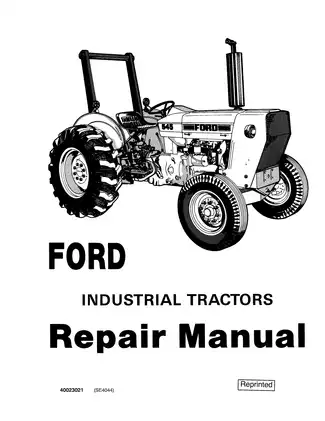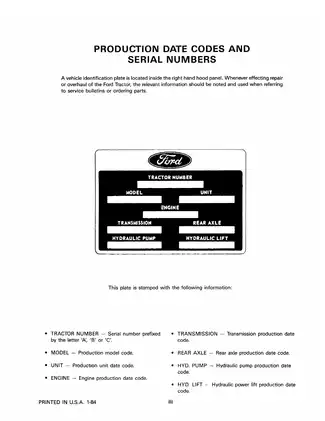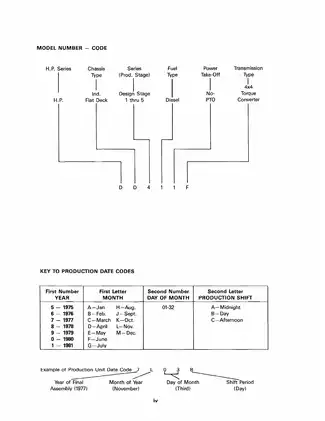Comprehensive Ford Tractor Repair Manual (1975-1983)
Product Gallery

Sample pages from the Comprehensive Ford Tractor Repair Manual (1975-1983) manual



Purchase Information
Comprehensive Ford Tractor Repair Manual (1975-1983) - Technical Specifications
- File Size:
- 100.37 MB
- File Type:
- Language:
- English
- Pages:
- 800 (12 sections)
- Printable:
- Yes
- Estimated Download Time:
- 2.06 Minutes
- Delivery Format:
- Digital (PDF) - Instant Access
- Category:
- Tractor
- Brand:
- Ford
Ford Models and Parts Covered in this Tractor Manual
- Ford 230A (1975)
- Ford 340A (1976)
- Ford 445 (1977)
- Ford 530A (1978)
- Ford 540A (1979)
- Ford 545 (1980)
Ford Comprehensive Ford Tractor Repair Manual (1975-1983) - Complete Manual Information
Comprehensive Ford Tractor Repair Manual (1975-1983)
This Ford Tractor Repair Manual is your ultimate resource for servicing and overhauling industrial tractor models manufactured by Ford from 1975 through 1983. Designed specifically for service personnel, this manual provides detailed instructions for proper repairs and maintenance procedures, ensuring your tractor operates efficiently and smoothly.
Why You Need This Manual
Whether you're a professional mechanic or a DIY enthusiast, having access to precise service information is crucial. This manual breaks down complex repair procedures into easily understandable steps, complete with diagrams and specifications. Save time and money by performing maintenance and repairs yourself with confidence!
What’s Inside
Table of Contents:
- Foreword - Introduction to the manual's use and layout.
- Safety Precautions - Essential safety guidelines for working on tractors.
- General Operational Principles - Overview of tractor operations and recommended practices.
- Engine Systems - Detailed insights into engines, lubrication, and common issues.
- Service Techniques - Recommended repair methods and tools required.
- Special Service Tools - Tools necessary for working on various tractor components.
- Hydraulic Systems - Comprehensive information on hydraulic systems, maintenance, and troubleshooting.
- Electrical Systems - Guidance on diagnosing and repairing electrical components.
- Troubleshooting - Steps to identify and solve common problems.
- Specifications - Important specs related to different tractor models.
This manual is not just a tool, but a guide that enables you to maintain your Ford tractor in optimal condition, enhancing its longevity and performance
Download Instructions for Ford Tractor Manual
Frequently Asked Questions - Ford Tractor Manual
What does this Ford manual cover?
This comprehensive service manual covers detailed repair procedures, maintenance schedules, troubleshooting guides, and technical specifications for Comprehensive Ford Tractor Repair Manual (1975-1983). It includes information for the following models: - Ford 230A (1975) - Ford 340A (1976) - Ford 445 (1977) - Ford 530A (1978) - Ford 540A (1979) - Ford 545 (1980).
Is this manual suitable for beginners?
Yes, this Ford manual is designed for both professional technicians and DIY enthusiasts. It includes step-by-step procedures with clear illustrations and safety guidelines for Tractor maintenance and repair.
What file format will I receive?
You will receive this manual as a PDF file (100.37 MB), which is compatible with all devices. The manual is fully searchable and printable for your convenience.
How quickly can I access the manual after purchase?
You'll receive instant access to your Ford Tractor manual immediately after payment completion. The download link is valid for 3 days, with lifetime re-download guarantee.
Does this include hydraulic system information?
Yes, this equipment manual covers hydraulic system operation, maintenance procedures, and troubleshooting for your Ford machinery.
Can I print specific sections of the manual?
Absolutely! This digital manual allows you to print any section you need, from individual pages to complete chapters, making it perfect for workshop use.
Ford Comprehensive Ford Tractor Repair Manual (1975-1983) Customer Reviews and Feedback
Read what our customers say about this Ford Tractor manual and share your own experience.
Add Comment
This policy contains information about your privacy. By posting, you are declaring that you understand this policy:
- Your name, rating, website address, town, country, state and comment will be publicly displayed if entered.
- Aside from the data entered into these form fields, other stored data about your comment will include:
- Your IP address (not displayed)
- The time/date of your submission (displayed)
- Your email address will not be shared. It is collected for only two reasons:
- Administrative purposes, should a need to contact you arise.
- To inform you of new comments, should you subscribe to receive notifications.
- A cookie may be set on your computer. This is used to remember your inputs. It will expire by itself.
This policy is subject to change at any time and without notice.
These terms and conditions contain rules about posting comments. By submitting a comment, you are declaring that you agree with these rules:
- Although the administrator will attempt to moderate comments, it is impossible for every comment to have been moderated at any given time.
- You acknowledge that all comments express the views and opinions of the original author and not those of the administrator.
- You agree not to post any material which is knowingly false, obscene, hateful, threatening, harassing or invasive of a person's privacy.
- The administrator has the right to edit, move or remove any comment for any reason and without notice.
Failure to comply with these rules may result in being banned from submitting further comments.
These terms and conditions are subject to change at any time and without notice.
Comments (2)